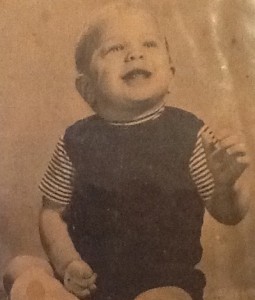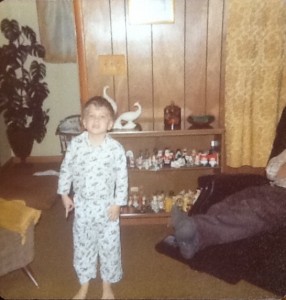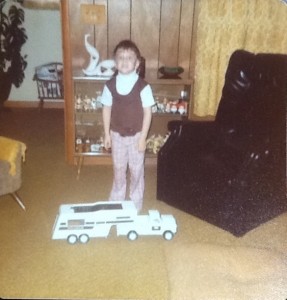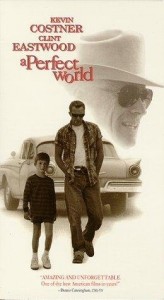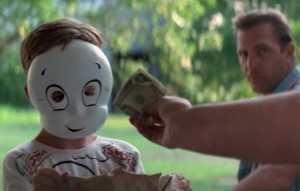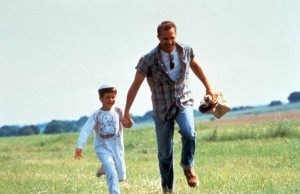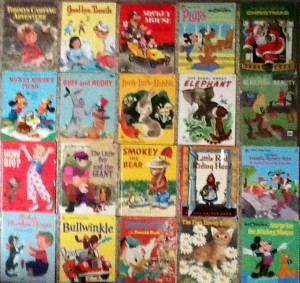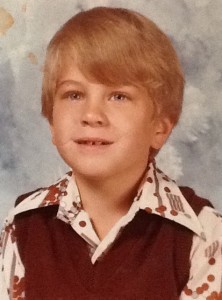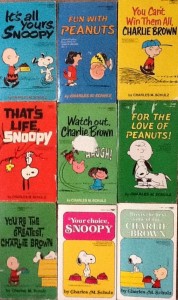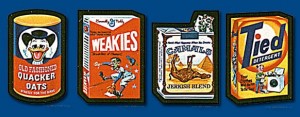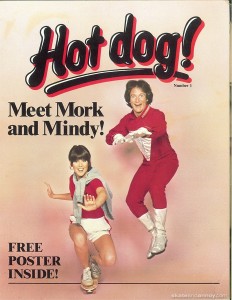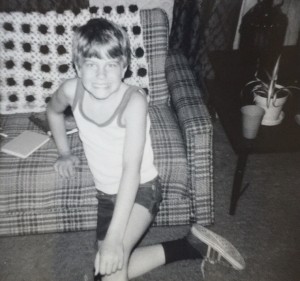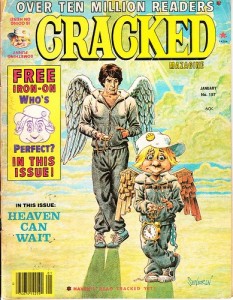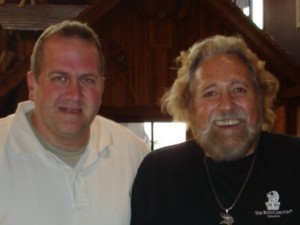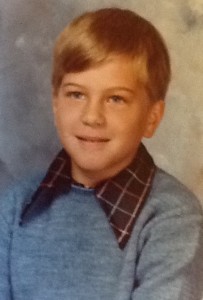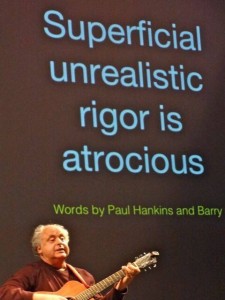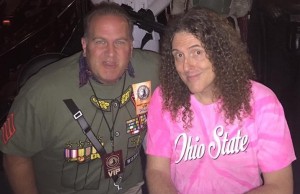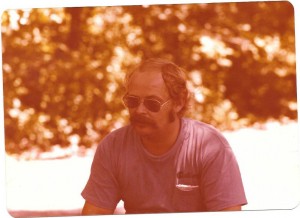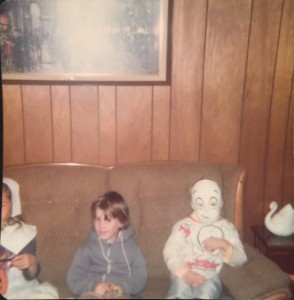Any good reading autobiography should start at the beginning, I suppose. But does this really make sense? At this age, I could barely hold a book let alone read one. . .so let’s flash forward a bit.
This might be a good place to pause. I recently lost my grandmother. She was important figure in my life. Borrowing a line from Titanic (a wonderful–though longish “text”), she “save me in the all of the ways a person might be saved.” Visiting her house soon after her passing, I was going through a bin of pictures she kept and I found some interesting pictures. . .of me. I knew that I spent a lot of time at Grandma’s house as a boy, but I did not know that these pictures even exsisted. But they did. . .and as wordless “text,” these photographs put me in a certain place at a specific time.
I was there. Then.
I was looking at the pictures here. Now.
The “text” allowed me to be in two distinct places at one time with the kind of discovery we want to happen when we introduce “text” to our students.
There. I am. Again. Standing in the same place. The same place I would be sifting through piles and piles of pictures, hoping against vain hope that I would find another of me that placed me firmly. Into a place. And a time. Two pieces of text. Different outfits. Could this have been the afternoon of the morning wherein the first picture was taken. There is photographic evidence to suggest this. With deep reading of the text, we could say that this text is chronological. This is good. This is the way a reading autobiography should read.
Flash Forward:
It’s 1993 or 1994–who can ever remember really when it was wherein we see the film that will change our lives in a powerful way. Oh, I guess I could point to the Winter of 1977 when my father, my mother, and I went into town–into the Gaslight District of Petoskey, Michigan to see this film called Star Wars. . .but I digress. And I get a Star Wars reference into the mix.
In 1993 or/and 1994, I was assigned as a Naval Hospital Corpsman with VFA-137 to a temporary assignment as medical crew aboard the U.S.S Constellation–or the “Connie” as we sailors would call her.
Before you could get wi-fi–even in “blue water” (that place in the ocean wherein you are so far out that you cannot even fly a plane from the deck to the shore), we had to rely upon a closed-network of televisions in the different departments wherein we could see the daily announcements or catch up on ship activities. At night, the media department would air the films they had on hand as we left for our sixth month cruise. One of those films was A Perfect World, starring Kevin Costner and Clint Eastwood. I fell in love with this film and I felt drawn to it in a way I could not describe then, but I can try to now, some two decades later.
The film follows a character Butch, who kidnaps a young boy, Phillip, on Halloween night. Phillip, whose family belong to the Jehovah’s Witness belief system has never gone trick-or-treating. He watches as his friends go from door to door, even greeting them at his own door trying to explain his inactivity.
In the course of their accidental journey together, “Butch” holds up a country store and adds a Halloween costume to his “take-away.” For the rest of the film, we see “Phil” in this costume as he trick-or-treat–a day or two too late–from the people Butch and Phil encounter.
It’s a sweet film featuring an antihero that Campbellians like me just love to “read in the dark” and analyze under the light of the monomyth.
But how does a film made in 1993 or 1994 connect to pictures taken of me in 1973 or 1974? What is the connection? And what does this have to do with “text” and how “we are the text we encounter” and how “the text can be in us and we can be in the text?”
We break the rules of autobiography and skip back a little bit.
Oh, we could go here. It’s the staple of early literacy for children of the 60’s and 70’s. But let’s not stay here for long. We have a connection to make.
This is me. I am in the first grade. I am in love with Ms. Gaylord (I wouldn’t fail to miss the “Ms.” and all of the opportunities this could present for a seven-year-old; I was given to small crushes and I would be crushed many times for it). It was in Ms. Gaylord’s room that I anxiously awaited the Scholastic Book Order forms to come. And I would wait even longer for the books my parents could afford to come in. . .to be sitting on the window sill with my slip rubber-banded around the small stack of treasures.
Treasures:
Okay. . .we are a little out of chronological order here, but I want to capture the time. I was a Wacky Packages, Odd Rods, TV GUIDE, Reader’s Digest, True Confessions (my other grandmother left these lying about and. . .hey. . .it was text) and anything else I could get my hands on reader.
I was culturally-literate before it was an education buzz phrase. The “text” offered by television was matched reference-for-reference with with what I was reading in print.
I was steeped in the culture as a younger reader and my budding “Seeker” archetype was insatiable. I was a non-fiction reader before it became a focus for the standards. I couldn’t know enough about Mork and Mindy or Lou Grant or M.A.S.H or 60 Minutes (you can hear the ticking, can’t you; this is the power of “audible text”).
I was a rebel reader. I loved funny. I loved snarky. I loved the one-upsmanship of a Snappy Answer to a seemingly Stupid Question.
And. . .I was a good Jehovah’s Witness boy.
There I am. Another text. This is probably a Sunday or a Monday afternoon and I am “underlining” a Watchtower Society “text” for a Tuesday night meeting. I would read the passage, find the corresponding question at the bottom of the page, and I would find the answer within the text. I was doing this at seven, eight, nine, and into my teens. I could close read with the best of them. I read like a detective and report back like a repenter.
Maybe we are getting closer to that film for which we were trying to make a deeper connection. For the boy who couldn’t watch films like The Omen or Jaws or even Close Encounters of the Third Kind, had to sit in the hallway during birthday parties, and had to mask the fact that he knew every word to every disco song of the time never gave up on text. I wouldn’t know the word for it at the time, but to give up “text”. . .to give up “me” would have been a non-negotiable.
And there were many times when these would find their way into the creases of a Watchtower or Awake magazine:
But this is about connection and not confession. And MAD magazine found its way into my book bag on more occasions than my phonics book (more confession–Sorry Mr. Beech ((4th grade)).
And it was during this time that I would still read all of the Little House series. All of the Mrs. PiggleWiggle books (okay. . .who else is excited about the reboot coming soon). Grizzly Adams–on the big screen, the small screen, in the pages, and in the coloring books.
And who wouldn’t be excited to see this fellow walk into a Great Wolf Lodge near Kings Island:
Okay. It was only me. And he couldn’t believe that I recognized him. But how wouldn’t I? He was a part of my “text” as a child. He was a part of “me.” The “text me.”
The text and I are moving closer to 1993. And closer to the me I am today. Look another picture. Another sweater. This was happening even back then, though I cannot find the spread colors with this much sass anymore.
This kid was into MAD, The Muppets, Rick Dees’s “Disco Duck” (which I still think is absolute genius by way of composition). It was at this time that I first encountered Weird Al Yankovic–“Another One Rides the Bus,” “My Balogna,” “Ricky” each “text” that Al put out there for the world to cheer or jeer was so very familiar to me that even today I cannot resist parody:
I was excited to find out that in 2015, MAD magazine handed over a whole publication–the first time in its history to do so–to guest editor. . . .Weird Al Yankovic. And in the summer of 2015, I got to do this:
You only get one minute with Al. And I wasn’t going to waste the moment. You can tell my mouth is moving in the picture. I’m telling Al that each project he ever released was like a “weird kind of home for me.” And it’s true. Al’s reponse was genuine. He said, “I’ve never heard my work described that way before.” We were serious together for about .5 seconds. And then. . .we went back to our individual lives. . .our “texts.”
Are we getting closer to a connection between 1974 and 1994 and 2015? Not until I introduce you to:
My step-father. Millard Dancy. I knew him as a boy. But I lost him as an adult when he and my mother divorced in the early 90’s. You’ll never know until you reflect upon it deeply what an influence an avid reader can have on the life of a child who is just coming into reading.
Millard would read anything from the spinning rack near the checkout of the party store. Often, this meant those “true crime” novels that were so popular in the 70’s. I would see Millard lay in bed on his side, one arm propped in the air holding one of these books (I always liked the inside of these with the photographic “text”–though the memory of seeing the Helter Skelter images still freaks me out a bit). For Millard, reading was a pleasurable activity and he filled his non-working, non-interactive time with a book.
And it/he was a model for me during those years. During those years when I saw no other adult reading, it was Millard, a hard-working steel salesman who loved cheap beer and a bad joke that served as a “text” for me. The reader. The one who enjoys reading. The one who reads even though he isn’t in school. The one who doesn’t ask permission to read what he wants to read. The one who reads. . .what he wants to read.
His name was Millard Dancy.
In my youth, I called him, “Daddy. . .Butch.”
All of Millard’s friends called him “Butch.”
And the connection becomes so clear now. The “text” keeps coming back to me. . .because I keep coming back to the “text.”
The “text” is “me.”
“Text. . .me.”
So what of a film that featured a convict that kidnaps a young boy and steals for him a Halloween costume?
We have to go back to the picture bin:
1974.
That’s me. On the right.
The “text” comes back. To “me.”
Let’s let this sit for the afternoon and let our friends come to this. Tomorrow. . .tomorrow. . .let’s break down what might happen for a generation of readers with little sense of “self” by way of “text.” The current perspective regarding reading for too many young people is “text. you.”
We can help them.
